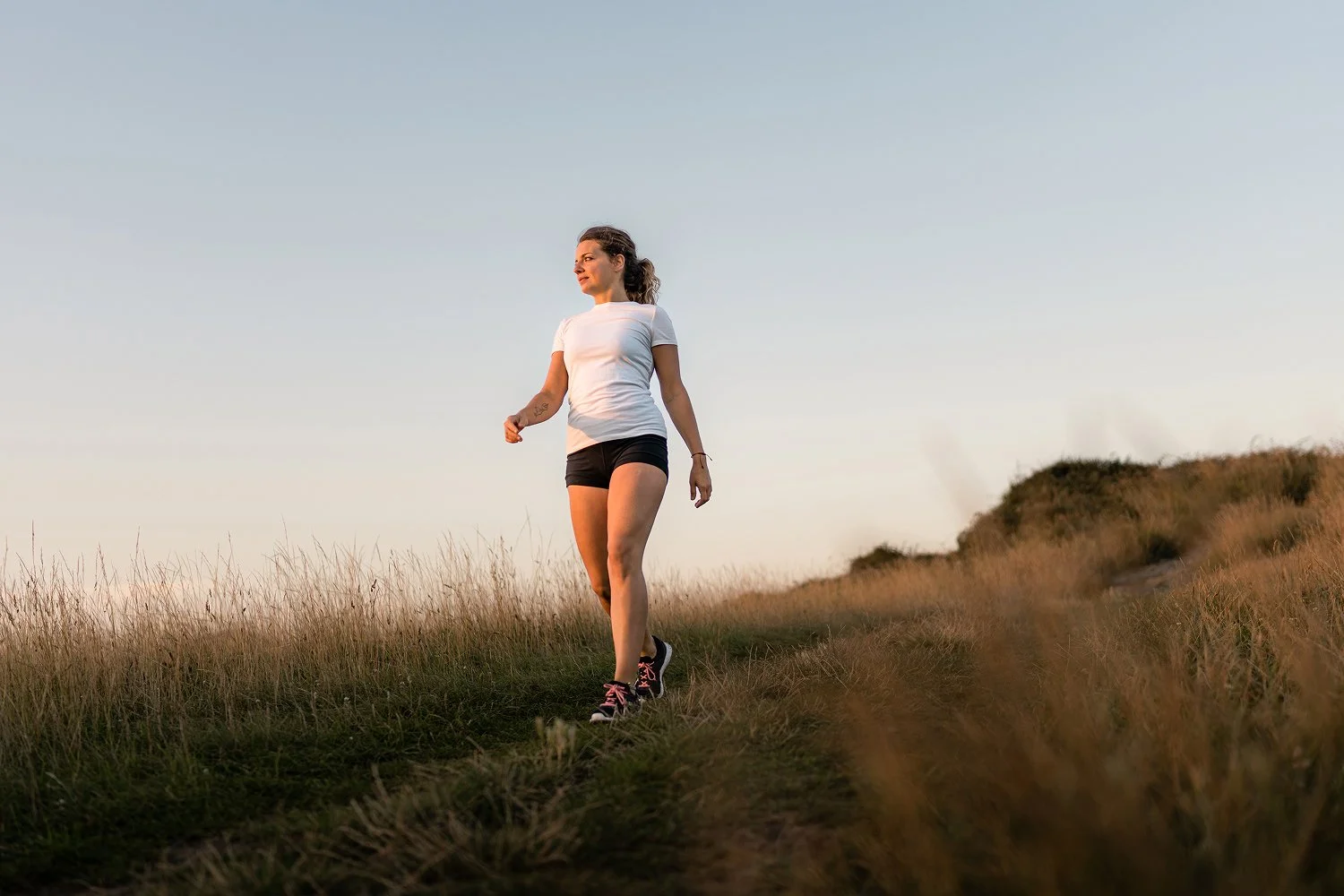How to use the viral "Japanese walking" trend to boost your health

Clinically reviewed by Dr. Chris Mosunic, PhD, RD, MBA
“Japanese walking” is trending online, with potential benefits ranging from improved heart health to weight loss. We’ll look at the claims and give you 10 tips to safely test it for yourself.
You know you’re supposed to exercise regularly, but fitting in a workout isn’t always easy. But what if getting in better shape just meant stepping outside for a short time? That’s where Japanese walking—also known as interval walking training—comes in.
The method alternates short bursts of brisk walking with slower recovery intervals. At first glance, it may look like nothing more than picking up the pace and then easing off, but research out of Japan suggests the structured rhythm could bring real benefits: stronger muscles, healthier blood pressure, even sharper mental focus.
The best part may be how accessible it is. Unlike many fitness trends that demand intense commitment or specialized gear, almost anyone can do Japanese walking. Here’s everything you need to know about how it works, why scientists are studying it, and how to try it for yourself.
What is “Japanese walking”?
“Japanese walking” is shorthand for a training approach called interval walking training (IWT). Developed at Shinshu University in Japan, it involves walking quickly for a short period of time and then taking time to catch your breath.
A typical routine is about three minutes of walking at a pace so fast that conversation feels difficult, followed by three minutes of slow walking.
This built-in recovery is critical, as it makes the workout more approachable than high-intensity exercise and more effective than a steady stroll. And because all you need is a safe place to walk and supportive shoes, it’s flexible enough for most fitness levels and routines.
Is there science behind the Japanese walking method?
There is science behind the Japanese walking method, but the body of research is still relatively small. With that said, studies from Japan have consistently shown that IWT carries measurable health benefits.
A landmark 2007 study found that interval walkers lowered their blood pressure more than people walking at a steady moderate pace. They also improved their aerobic capacity, which is a key marker of cardiovascular fitness. Later research linked IWT with stronger thigh muscles, better blood sugar control, better sleep, reduced fatigue, and even improvements in mood.
It’s important to note that most of these studies are short-term, and the research is still out on how IWT compares with other exercise methods that have been studied for decades. Also, the Japanese walking method hasn’t been studied extensively in people with advanced heart disease, serious joint issues, or significant mobility limitations, so medical clearance is important in those cases.
5 benefits of the Japanese walking method
The Japanese walking method is a mindful approach to exercise that can boost both your physical health and your mental clarity. Here’s how:
1. Supports heart health: The Japanese walking method can improve your blood pressure and aerobic capacity, which means your heart and lungs can handle daily demands with less strain.
2. Builds strength where it matters: The faster intervals work your leg muscles, and stronger legs help with balance, reduce fall risk, and make carrying things or standing up easier.
3. Helps manage weight and metabolism: Interval walking can support healthier blood sugar levels and cholesterol. It can also help stabilize your energy and contribute to your overall metabolic health.
4. Boosts mood and mental well-being: Many walkers notice better sleep, less fatigue, and clearer focus after a few weeks. This is because alternating between brisk and slow intervals offers a natural rhythm that energizes your body and gives your mind recovery time.
5. Easier to stick with than HIIT: Because Japanese walking has a lower impact on your body and requires little to no equipment, you’re more likely to make it a long-term habit than some other workouts.
Related read: 5 benefits of full-body workouts for your mental health
How to try out the Japanese walking fitness trend: 10 tips to get started
The Japanese walking method is a gentle and low-pressure way to move your body and clear your mind. Here are some tips to help you make it part of your daily routine.
1. Start with a realistic baseline
Do one 15–20 minute walk at an easy pace and notice your breathing, any discomfort, and how you feel after. That’s your baseline.
Related read: What is mindful movement? Plus 9 ways to get started
2. Pick an interval that fits you today
Choose an interval that works for you in your current condition, and be sure to include 3–5 minutes of a warm-up and a cool-down, no matter what. Your warm-up might include ankle circles, gentle knee lifts, shoulder rolls, and a slightly quicker walk. A cool-down should be an easy stroke with light calf or hamstring stretches or a few slow heel raises.
Remember that during a fast interval, you shouldn’t be able to hold a conversation. During a slow interval, you can talk with ease.
Beginners: Walk briskly for one minute and then walk slowly for one minute. Repeat this for 6–8 rounds.
Standard: Walk briskly for three minutes and then walk slowly for three minutes. Repeat this for 4–5 rounds.
Short on time: If you don’t have a lot of time, walk briskly for 90 seconds and walk slowly for 90 seconds for 6–8 rounds. Your warm-up and cool-down can be about a minute long.
Related read: Working out in the morning: benefits and 14 tips to get started
💙 Get your body ready for Japanese walking by doing Mel Mah’s Warm Up routine ahead of time.
3. Use simple tools to stay on track
Set a repeat timer on your phone or watch to keep yourself on pace.
You could also use songs as cues. Just choose an upbeat track for your fast interval, and a chill one for your slow walk.
4. Treadmill settings that work
When the weather doesn’t cooperate, use a treadmill instead. Your speed and incline depend on your fitness level and comfort, but you might try a slow pace of 2.5–3.2 mph with a 0–1% incline and a fast pace of 3.6–4.6 mph with a 1–3% incline.
Related read: How to push through a workout mentally: 7 tips to stay motivated
5. Mind your form
Focusing on your form can help you maximize the benefits of Japanese walking. Maintain a tall posture, relax your shoulders, and keep your eyes fixed straight ahead. Shorten your stride a bit during fast intervals to keep it smooth.
6. Choose shoes that feel good now
Any comfy walking or running shoe with decent cushioning and a secure heel is fine for the Japanese walking method. If your toes feel cramped, replace your shoes with a wider-toed pair so you don’t hurt your feet.
7. Make it social
Making regular plans to walk with a friend for the slow intervals can help keep you motivated. You could also designate an accountability buddy to text after your workouts.
💙 Remind yourself of the importance of connection by listening to Mindful Friendships with Jay Shetty.
8. Fuel up and hydrate
If you’re just going for a 30-minute walk, all you need is a water bottle. But if you’re walking first thing in the morning, eat something small beforehand to make sure you have enough fuel. Try having half a banana or a few crackers 15–20 minutes before you walk.
9. Mind your joints
If your joints give you problems, walk on softer surfaces, like special tracks or nature trails. Trekking poles can also reduce the load on your body. But if you’re experiencing persistent pain, modify your walk or rest.
10. Know the red flags
Listen to your body. If you notice chest pain, severe shortness of breath, dizziness, or swelling in a leg, stop. Always call your doctor if you have any concerns.
Japanese walking FAQs
What is the Japanese walking method?
The Japanese walking method, also known as interval walking training (IWT), is a structured form of walking that alternates between brisk, higher-effort walking and slower, recovery-style walking.
A typical pattern involves three minutes of faster walking, followed by three minutes at an easier pace. Repeat the cycle for about 30 minutes, four or more times a week.
This rhythm asks your body to work harder in short bursts and then gives it time to recover, helping you to build cardiovascular fitness and muscle strength without overwhelming your system.
What is a good 30-minute Japanese walking routine to try?
A balanced routine usually begins with a warm-up, cycles through brisk and easy walking, and ends with a cool-down.
Start by alternating between three minutes of brisk walking and three minutes of slow walking. Do this for four or five rounds, and then finish with five minutes of relaxed walking.
If you’re having a tough time, try shortening the brisk intervals to one or two minutes and lengthening the recovery periods.
Is Japanese walking good for beginners?
Japanese walking is one of the most beginner-friendly approaches to exercise because you can start with shorter brisk intervals and progress gradually as your fitness improves.
This flexibility makes it easier to stick with than workouts that demand maximum effort from the very beginning. And because it’s low-impact, it’s also gentler on your joints than running or plyometric exercises.
Can Japanese walking help heart health?
Studies from Japan have found that interval walking can lower blood pressure and improve aerobic capacity more effectively than continuous moderate walking. The stop-and-go pattern seems to challenge your cardiovascular system in a way that builds your resilience without requiring a ton of effort.
While this workout can be a very useful addition to a heart-healthy lifestyle, if you have a history of heart conditions, check with your doctor before starting.
Do I need special shoes for Japanese walking?
You don’t need specialized gear, but the right shoes can reduce your risk of aches or blisters. A pair of supportive running shoes with a good cushion is typically enough.
Still, if you notice discomfort in your feet, ankles, or knees, try visiting a running store to get properly fitted.
Calm your mind. Change your life.
Mental health is hard. Getting support doesn't have to be. The Calm app puts the tools to feel better in your back pocket, with personalized content to manage stress and anxiety, get better sleep, and feel more present in your life.







